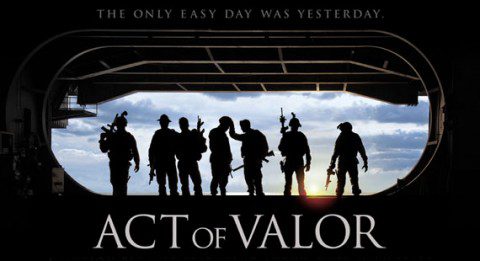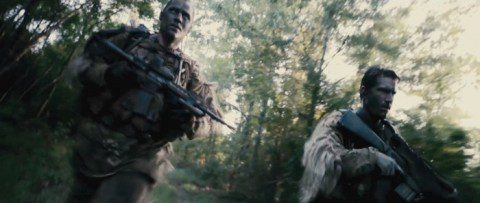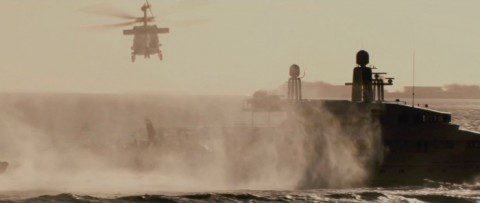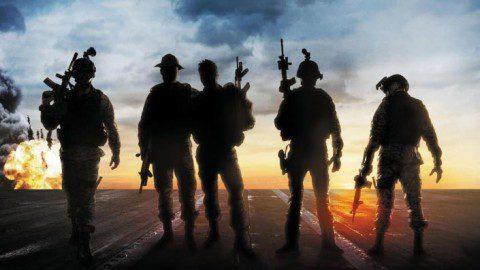With the new film “Act of Valor” — starring real-life U.S. Navy SEALs and real live-fire scenes in which the movie crew kept their heads down as live ammunition ripped overhead — movie makers Mike McCoy and Scott Waugh would like to think they’ve invented a whole new kind of movie.
 “Act of Valor,” which is released this weekend, is a mixture of reality TV, live action feature and cinema’s early years in which Thomas Edison’s cameramen risked risked life and limb to capture the real world for audiences just getting hooked on “moving pictures.”
“Act of Valor,” which is released this weekend, is a mixture of reality TV, live action feature and cinema’s early years in which Thomas Edison’s cameramen risked risked life and limb to capture the real world for audiences just getting hooked on “moving pictures.”
But the former actors, who have worked almost every job in front of and behind the camera, want to dispel a story going around about “Act of Valor” – that it began as a Pentagon training or recruiting film. That rumor has made some of the biggest newspapers and wire services.
Training under very real conditions
“We are laughing at the myth — and enjoying the story,” chuckles Waugh. “But it never started out like that. ‘Act of Valor’ has always
“It started out as an exploration into what would even telling the story of the SEALS look like,” says Mike “Mouse” McCoy – whose credits include producing, directing, writing, acting and just about everything else except makeup and catering. He was a stuntman in 2004’s “Flight of the Phoenix.”
A chopper at sunset
The project began with the two exploring “How would you even go about” telling the SEALs story, says McCoy. The Navy “opened the doors to us. We got to meet the men, really connect with the culture and from there we figured out what it meant to be a SEAL — these truly incredible and heroic men, their depth of brotherhood and the sacrifices they laid down in years of deployment.
“We began to see,” says Waugh, “the only way to make this movie was to film the real guys and honor their real stories.”
Jungle deployments
“Initially we were going to make an action film with professional actors,” says Waugh. “But once we met the men, we realized that they
were incredibly talented and competent and there was so much honor in this community. We began to realize that the only way to do it was for real.”
But filming reality has its limits. For example, the Pentagon wasn’t going to let Waugh and McCoy tag along on the mission to take out Osama bin Laden — or any other real combat mission. The compromise was to allow them to, as Waugh explains it, “augment existing training evolutions.”
Desert deployments
That was real enough. SEAL training is brutal. It takes over 30 months to train a candidate to the point at which he is ready for deployment. Those who make the cut emerge ready to handle pretty much any task under fire, which includes diving, combat swimming, hostage rescue, navigation, negotiating with civilians you’re trying to rescue, improvisation under extreme stress, creative use of explosives, expertise with a wide range of weapons and jumping out of moving vehicles, boats and aircraft.
The explosions are real -- and so are the bullets
SEAL training pushes recruits beyond human limits – mentally, emotionally and physically. Having the absolutely impossible
demanded eliminates those who are unable to pull off demanding missions and unexpected situations in which inventiveness, strength, cunning, team-spirit, mental toughness and versatility are vital.
And that’s what Waugh and McCoy show – how from Day One, trainees learn their lives depend on teamwork as well as willingness to sacrifice everything for their buddies. Navy SEALs have never left another SEAL behind on a mission. But filming that story while keeping out of the way was no easy task.
Open water rescue
“It’s important to note that no Navy assets were diverted into making this movie,” notes Waugh. “We worked around existing training operations and that’s why it took over two and a half years to shoot — and four years from start to finish.
“For four years,” says McCoy, “we were humbled and honored to be invited into the world of Navy special warfare, to take a look at their story. We spent a lot of time meeting the men and hearing the stories.”
Six months into the project, they identified five true-life acts of valor that had actually happened in the last 11 years. So, McCoy and Waugh hired screenwriter Kurt Johnstad to craft those incidents into a movie.
“Act of Valor” isn’t a documentary — it has a plot, including a damsel in distress.
Forest snipers
When her rescue in Latin America leads to the discovery of a deadly terrorist plot against the U.S., a team of SEALs is dispatched on a worldwide manhunt. The valiant men of fictional Bandito Platoon race to stop a coordinated attack that could kill and wound thousands of American civilians — but must balance their commitment to country, team and their families back home.
Reviewers are marveling that this is not yet one more Steven Segal-type good guys vanquish evil movie. Everything about it looks real — because it is real. Or is it?
This scene features a real U.S. nuclear sub
“We worked around training evolutions and combat deployments,” notes Waugh — since the Navy wasn’t going to jeopardize any true-life combat missions by letting the filmmakers tag along. “During the making of the film, every one of these guys went on full combat deployments all over the world. It’s important to mention that the SEALs in this film are not acting. They’re not playing a character. They’re just being themselves in their own world.”
“This is a brand-new type of movie,” says McCoy. “This is a real-life action film. There are no computer-generated special effects, no actors
faking it on a green screen or flying around on wires. This is all for real.”
Real SEALs, real families, real stories
Were there any surprises? “The sacrifices made by their wives and children,” says Waugh, “seeing the heroic women there who support their men. That’s something you really don’t consider until you see it for yourself. We were so fortunate to use the real-live wives and children in the film – to give moviegoers a peek behind the curtain.”
But doesn’t that put the SEALs wives and kids at risk?
“Well,” says Waugh, “all we can say is that the way we went about it, none of the SEALs were worried about it. I really can’t say anymore.”
One criticism of the film is that it shows too much.
No, disagrees McCoy. “The Navy scrubbed the film for ‘TTP’ — technique, tactic and procedure. They made sure we weren’t giving away anything classified. The last thing we wanted to do was to give the playbook to the bad guys.”
Does the film offer any misinformation so as to lead America’s enemies astray?
There is a pause, then, “No,” says Waugh, “No way were we playing any games. We’re really just showcasing what the SEALs are all about.”










